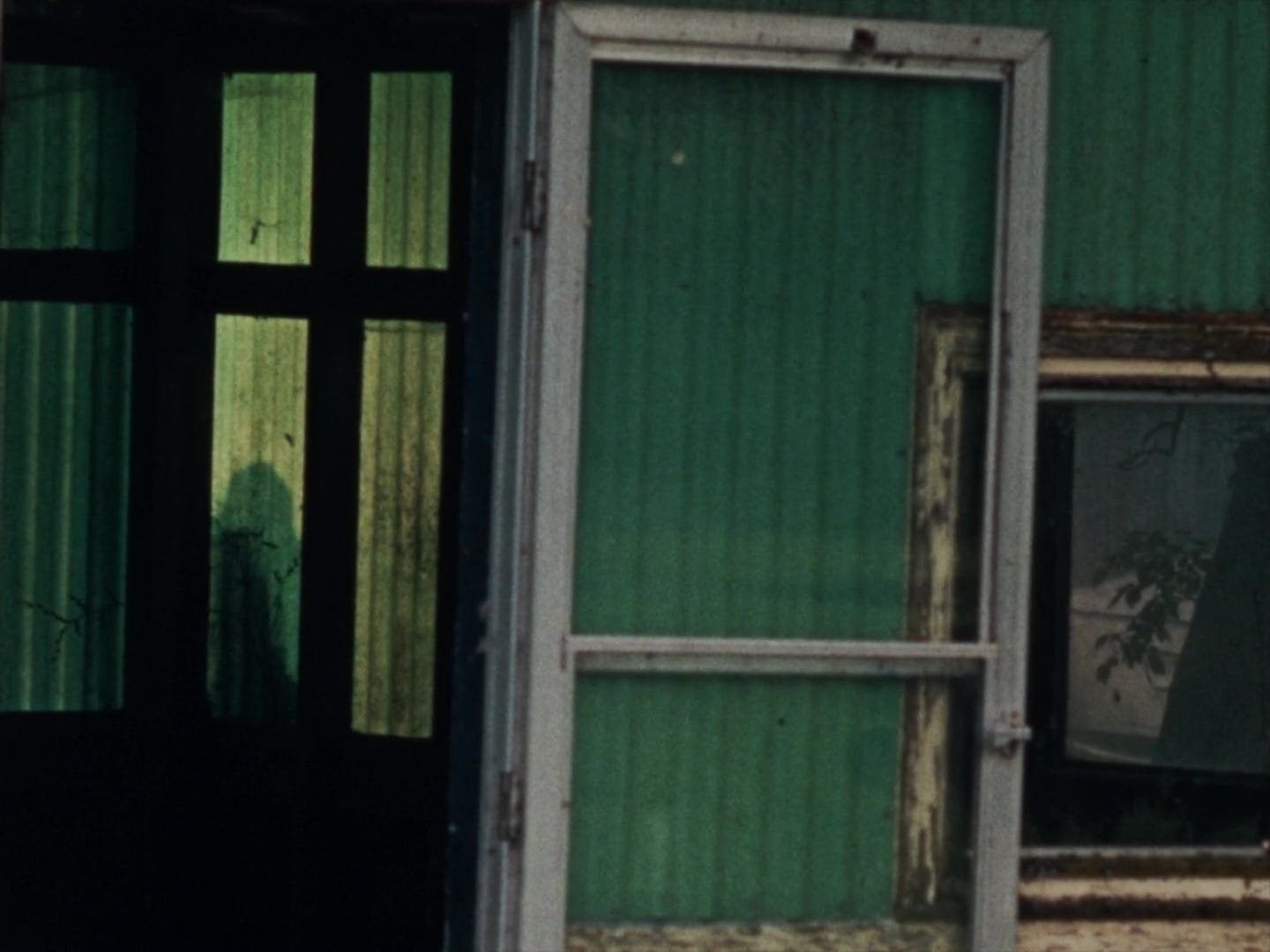◡◶▿ ROTT02 | Surfaces
📺 The mysterious cine-membrane between you and your audience. Plus: Glitch fest TODAY - anti-manuals - Vermette - Menkman - VHS -> iOS. | Rotting the Image Week 02
Unfound Peoples Videotechnic (UPV) is a roaming absurdist film school. You’ve found us amidst a weekly program of micro-essays on the ‘odour of a film’s look’: how to creatively mis-use cinematography and all your other tools to give your images life and, inevitably, death.
You are very welcome to dip in or sign up. Don’t worry about reading these lessons out of order. Each functions independently. They are sent in a sensible sequence but hardly reliant on it.
Please make yourself comfortable. Do you remember last week’s opening lesson? We learned how:
For a film to truly live, it must stink a little of its own potential death.
This scent is realised through the ‘odour’ of a film’s look.
The filmmaker has infinite tools and variables which she can and must modulate to achieve the appropriate ‘look’ - if her film is to truly live.
The odour is both a puzzle and a clue for the audience to access a deeper feeling for the movie.
In today’s lesson, we will discuss how:
📺 The image surface is the bit between the viewer and the image volume - a question of intimacy, then.
💧 The characters and events and other things depicted in the image volume leak selectively through the image surface.
🍯 There are lots of special sauces for the filmmaker to use on the image surface, but she must know where to get them.
⚪ Plus: an exercise in exploiting Rauschenberg for the multiplexes.
You’ll also find FOUR tip-offs about movies to see, festivals to attend, talks to which you might listen, and anachronistic image transfer techniques in which to get tangled.
The image surface
You can hear me deliver this lesson by scrolling up to the header and clicking Listen and/or the play ▸ button.
A bold word or phrase indicates that an instruction of the same name and concept appears elsewhere in this module.
The image surface is what goes on top. It is the nearest part of the movie that the viewer can see. The filmmaker adjusts the image surface to modulate the viewer’s access to the image volume. So, image surface is a question of intimacy.
In fact, the viewer collaborates by providing the television glass or visiting the cinema screen that holds the image surface. But this is just the viewer’s end of the bargain. The viewer has extended their zone of intimacy as far as they can. The rest is up to the filmmaker and her mediators.
The proximity of the image surface may cause frustration for the viewer. Frustration? The image surface borders the viewer’s world. It appears to be tangible, but it is not.
For example, the viewer can never run their hands through the film grain. Nor trace their finger around the rim of a cue dot. Nor chill the soles of their feet on a cool digital patina. They can press their blisters against the screen - but the screen is not the image surface.
The filmmaker might provide instructions to better achieve an illusion of touch. Even without prompting, the viewer augments the image surface with the atmospheric properties of the room. The filmmaker might ask the viewer to switch off the lights. Or to open a window or put their hand in their neighbour’s pocket.
Image surface as membrane
The image surface goes in front of the image volume. It is the first thing your audience will see and the first place you, the filmmaker, can hide. The image surface alters the viewer’s perception of several qualities of the image volume, including:
Aesthetic.
Meaning.
Feeling.
Visibility.
To achieve this, the filmmaker calibrates a range of variables. Common variables include lens choice, film stock, and the mistreatment of lenses and/or film material.
An effective image surface is a bridge between the world of the movie and its viewer. A semi-permeable membrane. Allowing the movie to pass from an area of high concentration to - even with the best intentions - an area of relatively low concentration. By modulating the properties of this membrane, the filmmaker controls the nature and substance of what makes it through.
Let’s take grain as an example of such a property.
Grain is one potential element of the image surface. Grain moderates the image elements that pass through the image surface. The grains block some light and hop aside for other light. This act of moderation changes the meaning and effect of what passes through.
The meaning and effect of what passes through is moderated by:
The tininess of the grain.
The filmmakers’ choice of grain density.
The coincidence of the frame rate with the grain rate (fresh grain with every frame).
The relative scale between the graininess of the grain and the graininess (or otherwise) of visual and non-visual elements of the movie beyond.
Visual examples include the graininess of the hero’s stubble, or the fluidity of the villain’s pen strokes.
Non-visual examples include the scuzziness of the voices or the morality.
The audience’s cultural relationship with film grain.
And all or any of the implications of these and more.
Phenomena of the image surface
An effective image surface is a semi-permeable membrane between the world of the movie and its viewer. By modulating the properties of this membrane, the filmmaker controls the nature and substance of what makes it through.
Grain is one example of such a property. Other examples include lens smears and the transfer path between shooting and exhibition (for example, transferring from digital to film; reshooting the entire movie from its reflection in a puddle).
The grain (or other surface quality) should feel as though it is of the movie’s world. The grain, or lens effect, or implied cause of the lens effect, should not be chosen:
willy-nilly from the filmmaker’s toolbox,
because it is fashionable,
nor solely because it is effective at masking an undesirable element in the image volume.
And it should never, ever be accepted as a default property of the equipment or environment with which the filmmaker finds themselves.
Instead, the qualities of the image surface are inspired or implied by the movie world. By the nature of what goes on in the image volume and in the implied world beyond. The physical and metaphysical nature of the diegesis. The filmmaker chooses from these sources to meet what she needs for her image surface.
(Although the characters’ world inspires these surface properties, the characters don’t know that the properties (grain and puddleness and what have you) are there. Up there between them and the audience. They cannot wilfully affect these phenomena. It’s just that these are the sorts of things they have there in their world.)
Sometimes, a filmmaker will draw elements of the image surface directly from a movie’s world. The most common use of this technique is when a movie purports to be ‘found materials.’ When the movie purports that the VHS lines or 8 mm grain were generated by characters or implied characters. Nothing wrong with that!
Exercise: Dust narrative
Please share your thoughts, queries, and exercises from this week’s lesson in the comments.
A how-to, and a how-not-to-how-to (and two how-about-that!s)
💔 This is timely: today and tomorrow (9th and 10th October), the Fubar Glitch Art Festival presents a program of Glitch Cinema, curated by Ejla Kovačević. At MaMa in Zagreb, but also online.
The program begins from foundations laid by Rosa Menkman’s “critical exploration of art works that incorporate noise & error as a means to examine and interrupt the normative function of the image and the media itself.” Yet, it acknowledges that “dirty glitch can be indeed very pretty.” In conclusion, the program promises “exciting, vibrant & noisy alternative visions that radically challenge the dominating clean, sterile imagery of contemporary digital cinema.” Well, yes. Right?
📘 Statistically speaking, none of you are in Belgium1. Still, Belgium is the country that produced:
the greatest character in a kitchen drinking coffee movie of all time, according to critics,
the bestest Belgian films of all time (including the cream of 1999-2006 era black and white absurdist comedy), and
Boris Lehman.
So, I imagine that materially or spiritually speaking, more than a few of you are living there undercover while you master your arts. In this case, let me draw your attention to Sabzian’s Roundtable: Anti-Manual / On the screenplay and alternative forms of writing for film. It takes place at the 50th Film Fest Ghent. On Thursday, October 19th, at 14.30 (Belgian time).
The talk is named after issue 710 of Cahiers du Cinéma. Issue 710 fancied itself a “scenario anti-manual: to point out the ideology of manuals, to deconstruct it and, above all, to propose an alternative.” Well, here at UPV, we spare no sympathy for the screenplay. But when you get speakers as interesting as Helena Wittmann, Radu Jude, and Nina de Vroome to chat about the death of the manual, you have our panicked attention.
For the UPV is nothing if not a manual, flattened out across infinite Monday morning emails. Not just *a* manual but *The* manual. Proposed to do just what issue 710 proposed: “to point out the ideology of manuals, to deconstruct it and, above all, to propose an alternative.” That alternative being this manual. The first and last great filmmaking textbook.
🎥 The films of Rhayne Vermette trouble much of today’s lesson. Oh, what Rhayne Vermette does to/with/under the image surface! Mussing it up, switching its position, concocting a whole new diegetic ontology of grain, volumising the anti-dimensional. Phew!
If you’re in New York, you missed her feature, Ste. Anne, at the Metrograph last night2. I suppose we all did. But it seems that some of her shorts will be broadcast on the Metrograph’s web channel starting this Friday. Enter if you dare!

📹 And here’s a video about how to record directly from your VHS camera to your mobile telephone. Why would you want to do that? I’m sure you have some good ideas. Let us know in the comments!
Anyway, it seems sad that this technique loses the tape wobble that is so integral to the classic VHS look. And some of the bulky, plastic physicality of the process. But the unwieldy cable/adaptor set-up makes up for that a little. You need something to trip you up!
And I believe the narrator mentions transferring from phone to tape to phone again, which seems like a sensible way to get his wobble back and discover some fundamental truths along the way.
Next week, we’ll learn about the image volume. The magic little box where it all happens: objects! drama! people! much of the odour! Leonardo DiCaprio, potentially! a unique form of physics that appears to be - but is not quite - the one acting upon you in your seat right now!
Class dismissed.
~Graeme Cole.
(Principal)
📹 Unfound Peoples Videotechnic | Cloud-based filmmaking thought. ☁️
ℹ️ About us 🐦 Twitter | 📸 Instagram | 😐 Facebook | 🎞️ Letterboxd | 🌐 Website
If you didn’t, raise your hand and let us know in the comments.








